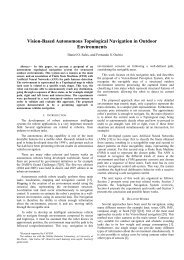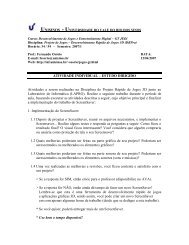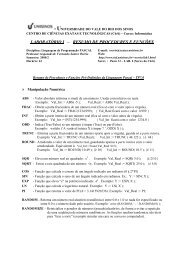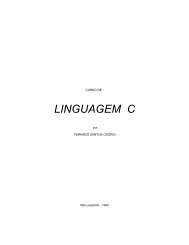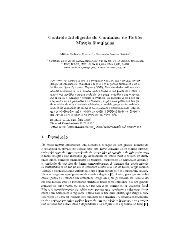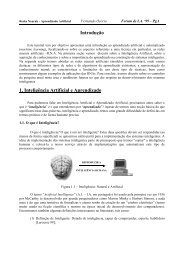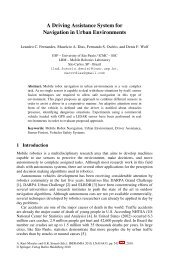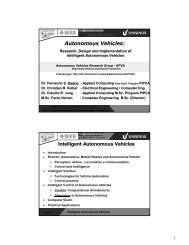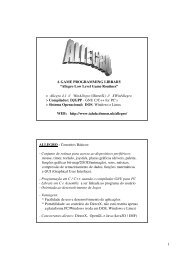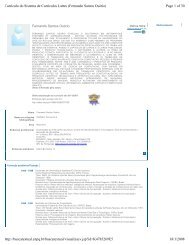Vision and GPS-based autonomous vehicle navigation using ...
Vision and GPS-based autonomous vehicle navigation using ...
Vision and GPS-based autonomous vehicle navigation using ...
Create successful ePaper yourself
Turn your PDF publications into a flip-book with our unique Google optimized e-Paper software.
3.2 Template Matching Step<br />
After obtaining the ANN classification, different road templates<br />
are placed over the image in order to identify the road<br />
geometry. One of them identifies a straight road ahead, two<br />
identify soft turns, <strong>and</strong> two identify hard turns. Each template<br />
is composed of a mask of 1s <strong>and</strong> 0s, as proposed in<br />
[17]. The value of each mask is multiplied by the correspondent<br />
value into the navigability matrix. The total score for<br />
each template is the sum of products. A good performance<br />
was obtained in the <strong>navigation</strong> defined by the urban path<br />
avoiding obstacles <strong>using</strong> the best template [16].<br />
In this step, templates are selected for use in the next step<br />
of the system. The template that obtains the higher score<br />
is selected as the best match to the road geometry.<br />
3.3 Occupation Percentage<br />
In this step, the templates of the previous step are used to<br />
calculate the occupation percentage of the road regions (navigable<br />
<strong>and</strong> non-navigable). This calculation is performed by<br />
dividing the template score by its maximum value. This is<br />
carried out for each template, so several values normalized<br />
between [0, 1] are obtained.<br />
After obtaining these values <strong>based</strong> on the occupation areas<br />
resulting from the classified images (navigable <strong>and</strong> nonnavigable<br />
- image processing step), we verify if the occupation<br />
percentage obtained is lower than a threshold level. It<br />
is then assigned as either obstructed (value 0) or free (value<br />
1) for the occupation areas, which are part of the system<br />
input for the next step.<br />
3.4 Learning Based Navigation<br />
We have already developed works analyzing different levels<br />
of memory of the templates <strong>based</strong> on examples obtained<br />
from human drivers <strong>using</strong> neural networks [15]. The results<br />
of these neural networks have also been compared with<br />
different supervised learning techniques for the same purpose<br />
[14]. This work is <strong>based</strong> in the integration of <strong>GPS</strong><br />
<strong>and</strong> compass, furthermore the occupation percentage on the<br />
<strong>autonomous</strong> <strong>navigation</strong> system.<br />
In this step, the basic network structure used is a feedforward<br />
MLP. The activation functions of the hidden neurons<br />
are logistic sigmoid <strong>and</strong> hyperbolic tangent, <strong>and</strong> the ANN<br />
learning method is the resilient backpropagation (RPROP).<br />
The inputs are represented by azimuth (difference between<br />
the current <strong>and</strong> target positions of the <strong>vehicle</strong>) <strong>and</strong> the<br />
five values obtained by the occupation percentage step (obstructed<br />
or free occupation areas). The outputs of the proposed<br />
method are the steer angle <strong>and</strong> speed (Figure 4).<br />
Figure 4: Structure of the second ANN used to generate<br />
steering <strong>and</strong> acceleration comm<strong>and</strong>s.<br />
283<br />
4. EXPERIMENTAL RESULTS<br />
The experiments were performed <strong>using</strong> CaRINA (Figure<br />
1), an electric <strong>vehicle</strong> capable of <strong>autonomous</strong> <strong>navigation</strong> in<br />
an urban road, equipped with a VIDERE DSG camera, a<br />
ROBOTEQ AX2580 motor controller for steering control, a<br />
TNT Revolution GS Compass (orientation) <strong>and</strong> a GARMIN<br />
18X-5Hz <strong>GPS</strong> (localization). The image acquisition resolution<br />
was set to (320 x 240) pixels. Figure 5 shows the <strong>vehicle</strong><br />
trajectory obtained by <strong>GPS</strong> coordinates.<br />
Figure 5: <strong>GPS</strong> coordinates performed by CaRINA.<br />
Seven <strong>GPS</strong> waypoints (desired trajectory) were defined.<br />
In order to navigate, the <strong>vehicle</strong> used a monocular camera to<br />
avoid obstacles. The experiment was successfully performed<br />
as it followed the <strong>GPS</strong> points <strong>and</strong> avoided obstacles. In some<br />
of the straight paths, the <strong>vehicle</strong> had to avoid curbs at the<br />
same time it was attracted by the <strong>GPS</strong> goal points, resulting<br />
in some oscillation in the final trajectory.<br />
Table 2 shows the values of the path performed by Ca-<br />
RINA. Five different ANNs topologies were analyzed <strong>using</strong><br />
two learning functions (logistic sigmoid <strong>and</strong> hyperbolic tangent).<br />
These topologies represent the architecture of the<br />
second ANN used in our proposed system. Several topologies<br />
of ANNs were tested to obtain the minimum training<br />
error <strong>and</strong> a near optimal neural architecture.<br />
The ANN architecture was selected considering the number<br />
of neurons in the hidden layer <strong>using</strong> the RPROP supervised<br />
learning algorithm in MLP networks <strong>and</strong> considering<br />
the values of MSE (Mean squared error) <strong>and</strong> the best epoch<br />
(Optimal point of generalization [OPG], i.e., minimum training<br />
error <strong>and</strong> maximum capacity of generalization).<br />
We also evaluated the ANNs modifying the learning functions.<br />
The main difference between these functions is that<br />
logistic sigmoid produces positive numbers between 0 <strong>and</strong> 1,<br />
<strong>and</strong> the hyperbolic tangent (HT), numbers between -1 <strong>and</strong><br />
1. Furthermore the HT is the activation function most commonly<br />
used in neural networks. After the analysis of Table<br />
2, the 6x15x2 architecture <strong>using</strong> the hyperbolic activation<br />
function showed the lowest MSE for the 10600 epoch. Five<br />
different runs were executed changing the r<strong>and</strong>om seed used<br />
in the neural networks (Tests 1 to 5).<br />
Figure 6 shows the histograms of the errors <strong>based</strong> on the<br />
best ANN topology obtained in Table 2. Topologies 4 <strong>and</strong><br />
5 were accepted <strong>based</strong> on the results. Figure 6(b) presents<br />
the error concentrated on zero <strong>and</strong> with a lower dispersion<br />
than the one in Figure 6(a). The same is true for Figure<br />
6(d), which shows a lower dispersion compared to Figure<br />
6(c), therefore encouraging the use of topology 5.



